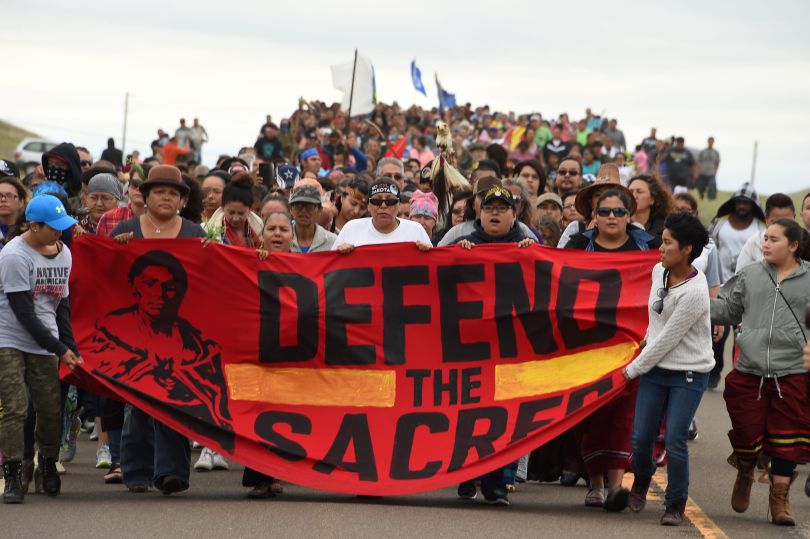North Dakota oil pipeline battle: who’s fighting and why
Photo by AFP/Getty Images
Native Americans march to the site of a sacred burial ground in North Dakota to protest of oil pipeline that will cross the nearby Missouri River.
November 9, 2016
The fight over the 1,170-mile pipeline has become an environmental and cultural threat, stirring passions across social media and drawing thousands of protesters to camp out in rural North Dakota.
According to The New York Times, the Dakota Access pipeline is a $3.7 billion project that would carry 470,000 barrels of oil a day from the oil fields of western North Dakota to Illinois, where it would be linked with other pipelines.
In keeping with that argument, Energy Transfer states that the pipeline will pump millions of dollars into local economies and create 8,000 to 12,000 construction jobs, though far fewer permanent jobs to maintain and monitor the pipeline.
Members of the Standing Rock Sioux Tribe say its route traverses ancestral lands, which are not part of the reservation, where their ancestors hunted, fished and are buried. Since April, people have been gathering outside Cannon Ball, a town in south-central North Dakota, near the South Dakota border, to peacefully protest.
According to The New York Times, starting with members of the Standing Rock Sioux Tribe, the protest has since grown to several hundred people, most of them from Native American tribes across the country.
More than 400 people have been arrested since the protests began, attracting widespread attention and thousands of followers on social media.
Protesters have set up teepee and tent camps on land owned by Energy Transfer Partners to slow the progress of construction and have threatened to block the highway, according to the Huffington Post. Last week, tensions rose after law enforcement tried to remove protesters from a camp they had set up on the land.
The police arrested 142 people in what local sheriffs describe as a riot. Protesters and supporters of the movement criticized law enforcement for an oppressive and rough response to their demonstration.
According to an Indigenous Rising Media video, over 400 people marched in silence for a prayer action led by the International Indigenous Youth Council Monday morning.
“We’re praying for our people. We’re praying for the land. We’re praying for the water. We’re also praying for all of you… in uniform. All of you who have to be here,” Terrell Catt-IronShell said.
They reached across the razor wire barricade and offered officers water that had been blessed in a ceremony.
The way that Native Americans are sharing peace and prayer should wake America up. We all need unity, now more than ever.
The Native Americans also worry about catastrophic environmental damage if the pipeline were to break near where it crosses the Missouri River.
Originally, the pipeline was supposed to cross just north of Bismarck, until people pointed out that a leak there would threaten the drinking water supply for North Dakota’s second biggest city. The solution, according to the government, was obvious: make the crossing through Standing Rock Reservation, where the poverty rate is nearly three times the national average.
The government needs to take this as seriously as they would if someone wanted to build a pipeline through Arlington Cemetery. There would be riots in the streets. Obviously, Arlington Cemetery is sacred ground to all Americans, just as Standing Rock, North Dakota is to all Native Americans.
This is the start of another Flint, Mich., except with a chance to stop it.
This is the kind of project that climate science tells us can no longer be tolerated. The Obama administration promised that there would be a climate test for new projects before they could be approved.
The president talks about climate change all the time. He wants to show that he takes climate change seriously, and he wants the US to lead the world in addressing the problem. He says no challenge poses a greater threat to our children.
As commander-in-chief, you would think that he could put a hold on the permits issued to build the pipeline while the administration evaluates the pipeline’s climate impact. To not issue such a request would call to question the president’s seriousness towards climate change. Are these new guidelines for show or are they to keep his legacy rather than to actually deal with the problem?






